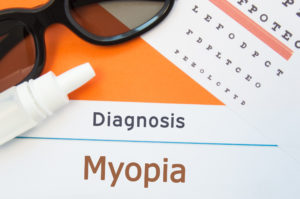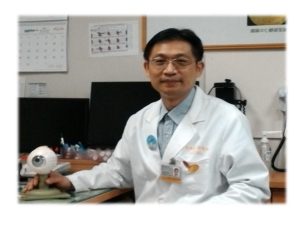March 1, 2020
By Pei-Chang Wu, MD, PhD
 The objective of myopia management is to slow the rate of myopia progression significantly, preferably by 50 percent or more per year.1 That would achieve the goal of substantially reducing the prevalence of high myopia (-5.00D or greater) by up to 90 percent. To date, topical application of atropine is the only evidence-based drug found effective for myopia management. In comparison to 1 percent (high dose) atropine, low dose atropine is advantageous as there are reduced side effects (photophobia and near blur) while maintaining effective myopia control. Furthermore, the use of topical low-dose atropine for myopia control in children is beginning to be widely adopted after positive results from large scale trials (ATOM2 and LAMP studies) as well as some real-world studies.2-4
The objective of myopia management is to slow the rate of myopia progression significantly, preferably by 50 percent or more per year.1 That would achieve the goal of substantially reducing the prevalence of high myopia (-5.00D or greater) by up to 90 percent. To date, topical application of atropine is the only evidence-based drug found effective for myopia management. In comparison to 1 percent (high dose) atropine, low dose atropine is advantageous as there are reduced side effects (photophobia and near blur) while maintaining effective myopia control. Furthermore, the use of topical low-dose atropine for myopia control in children is beginning to be widely adopted after positive results from large scale trials (ATOM2 and LAMP studies) as well as some real-world studies.2-4
The phrase “low concentration atropine” is commonly used to refer to concentrations of 0.01 percent, 0.025 percent and 0.05 percent. In the ATOM2 study, there were three phases: a first, treatment phase of two years with three different concentrations of atropine (0.01 percent, 0.1 percent and 0.5 percent); a second washout phase of one year with discontinuation of atropine; and a third re-treatment phase for only the fast progressors with 0.01 percent atropine for two years. At the end of phase one, about half of those treated with 0.01 percent atropine progressed > 0.50D/year. In the LAMP study, amongst the three concentrations (0.05 percent, 0.025 percent and 0.01 percent) that were trialed, 0.05 percent atropine was the most effective in slowing myopia progression and axial length elongation. Over half the individuals treated with 0.01 percent atropine progressed by > 0.50D/year, whereas in contrast, less than one-third of individuals treated with 0.05 percent atropine progressed by > 0.50D/year. This indicates that there is an individual variability, and we proposed and reported on a stepwise increase of atropine dosing method to find the best concentration for myopia control for a given individual.5
When to Taper
There are two strategies to consider for stopping atropine treatment. The first is to adopt the ATOM2 study approach with two years of initial treatment followed by a one-year washout period with monitoring. A second and more preferred alternative is to treat continuously until late adolescence. Considering ATOM2, more than half of the patients (192/345) were required to be re-treated; they were treated for an overall four years in the five-year study (in phase one and then in phase three). Therefore, long-term treatment with atropine eye drops in myopic children may be necessary.
It is also well known that progression slows down with age but may continue to late adolescence.6, 7 Also, younger-onset myopia progresses faster than myopia that onsets at an older age.8 In the 0.01 percent atropine group from the ATOM2 study, a higher percentage of the younger children (6-8 years old) required re-treatment at the end of the washout year in comparison to children 8-10 years old and 10-13 years old (62 percent, 27 percent and 8 percent respectively). It is thus advisable that treatment be continued until late adolescence (around 15-18 years old) and especially in younger-onset myopes. Considering the above factors, it is advisable to consider tapering atropine treatment after a certain age rather than the period of treatment. Especially in Taiwan, where I practice, children are exposed to high academic loads at schools and have a faster progression rate compared to other ethnicities, and therefore, treatment of myopia is continued at least until the individual is 18 years old.
How to Taper
- Stop completely
In ATOM2, the least rebound (myopia progression > 0.50D in the washout year) was observed in users of 0.01 percent (24.3 percent, 58.9 percent and 68.4 percent rebound with 0.01, 0.1 and 0.5 percent atropine respectively). For those receiving 0.01 percent atropine treatment, a complete stop of atropine use is an option for the cessation of myopia control treatment. Given the data, there exists a rebound risk of fast progression of about one fourth with this strategy. Therefore, monitoring progression every six months is recommended, and if myopia progresses by > 0.50 D after six months or a year, then re-treatment is indicated.
- Decrease dose or frequency
There is no data on possible rebound effects after cessation of treatment with 0.05 percent atropine. Therefore, in this situation, it is advisable to adopt a more conservative approach and taper by decreasing the dose stepwise and monitoring progression every six months. First, decrease the dose from 0.05 percent atropine to 0.01 percent atropine. If myopia progresses by > 0.50D after six or 12 months, re-treatment with the higher dose is recommended. A previous report suggested tapering by altering the frequency of use of atropine in the late teenage years.9 Decreasing the frequency of use is also an alternative, such as reducing frequency to two to three times a week or using the drops on days when there is less outdoor time or greater near workload.
After Cessation Continue to Monitor Periodically
It is advisable to monitor the myopia status for at least one to two years after cessation of treatment. Periodic checks at six to 12 monthly intervals after tapering or cessation of topical atropine treatment is important to identify any progression. Whether the myopia status is stable or progressive depends on several factors such as parental myopia, age, academic stress, near work and outdoor time. Myopia progression is still possible in adulthood, especially in groups with a higher near workload, such as microscopists or university students. Therefore, in addition to prescribing myopia control treatments such as atropine, a holistic approach to myopia management by advising work breaks and improved outdoor activities is essential. In myopia management, the practitioner should routinely adopt and advise health education of the eye for an individual.
- Holden B, Sankaridurg P, Smith E, et al. Myopia, an underrated global challenge to vision: where the current data takes us on myopia control. Eye (Lond) 2014;28(2):142-6.
- Chia A, Lu QS, Tan D. Five-Year Clinical Trial on Atropine for the Treatment of Myopia 2: Myopia Control with Atropine 0.01 percent Eyedrops. Ophthalmology 2016;123(2):391-9.
- Wu PC, Yang YH, Fang PC. The long-term results of using low-concentration atropine eye drops for controlling myopia progression in schoolchildren. J Ocul Pharmacol Ther 2011;27(5):461-6.
- Yam JC, Li FF, Zhang X, et al. Two-Year Clinical Trial of the Low-Concentration Atropine for Myopia Progression (LAMP) Study: Phase 2 Report. Ophthalmology 2019.
- Wu PC, Chuang MN, Choi J, et al. Update in myopia and treatment strategy of atropine use in myopia control. Eye (Lond) 2019;33(1):3-13.
- Rehm DS. THE MYOPIA MYTH: The Truth about Nearsightedness And How to Prevent It. Ligonier, PA, USA: International Myopia Prevention Assn., 1981.
- Sankaridurg PR, Holden BA. Practical applications to modify and control the development of ametropia. Eye (Lond) 2014;28(2):134-41.
- Chua SY, Sabanayagam C, Cheung YB, et al. Age of onset of myopia predicts risk of high myopia in later childhood in myopic Singapore children. Ophthalmic Physiol Opt 2016;36(4):388-94.
- Brenner RL. Further observations on use of atropine in the treatment of myopia. Ann Ophthalmol 1985;17(2):137-40.

Pei-Chang Wu, MD, PhD, a world-renowned atropine expert, is director, Center of Myopia Prevention & Treatment, Pediatric, and retinal ophthalmologist, Department of Ophthalmology, Kaohsiung Chang Gung Memorial Hospital, Taiwan, and a collaborator at the Brien Holden Vision Institute in Sydney, Australia.













